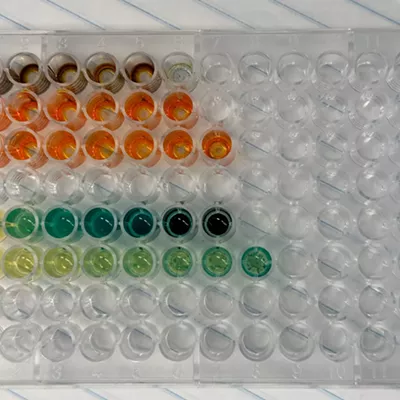The creatures are microscopic, in the most literal sense. They can be seen moving through the lenses of microscopes, in a sleek lab at Whitworth University's new science building. Through one microscope, there's the zebrafish. In the vivarium, small striped adult zebrafish minnows flit around in bubbling tanks. But in the lab, the fish are still in embryonic form, looking like tiny eggs-over-easy with transparent yolks.
The creatures in the other microscope are even smaller — dozens of translucent roundworms snaking about a petri dish.
And in the hands of associate professor Aaron Putzke and a few Whitworth undergrads, these tiny creatures could become weapons in the battle to understand, and ultimately conquer, many types of cancer.
Think of cancer as a kind of biological computer glitch: Something goes wrong in the body's signaling — cells that are supposed to divide, and then stop dividing, keep on dividing out of control. Just like a computer programmer trying to fix a glitch, scientists seek to replicate those errors, to identify the problem and find a solution.
So for 10 years — at Whitworth, Hope College and the Fred Hutchinson Cancer Research Center — Putzke has been trying to understand the role played by a single gene called Fer kinase. Scientists already know they're related to a protein found in malignant cancerous tumors called sarcomas. But precisely what role they play continues to be a subject of debate.
"We know it interacts with some proteins that allow cells to stick together," Putzke says. "In cancer a lot of times, the progression to more aggressive cancer is when cells don't stick together anymore... When cells don't stick together, they're not very good at talking to each other. That's when they go rogue."
In some instances of cancer, Fer kinase is overexpressed — the gene is pumping out too much of its protein. But in other cases, the gene isn't there — or isn't working at all. Putzke is studying the latter.
In the zebrafish, Putzke's team manually injects inhibitor molecules into each embryo, blocking the gene. In the roundworm, his team requested that a scientific consortium help them trigger mutations to remove the gene entirely.
In both cases, it wreaks havoc on the organisms. The way Putzke is able to see exactly how is a scientific marvel itself: A modified jellyfish gene is injected into these organisms, causing them to glow with a green fluorescence when exposed to UV light.
Putzke pulls up an image on his computer: With the Fer kinase gene active, cells from the zebrafish's tail appear organized into a clear, uniform structure. But with the gene inhibited, the circulatory system is thrown into chaos — the cells are piled in a formless clump. When fluorescent dye is injected into the vascular system, it shows the blood can't circulate properly.
"We think it's a dividing and migrating thing," Putzke says. "Cells are dividing too much. They aren't able to move and interact with each other in a way that they can organize. They don't form tubes."
In the roundworms, the impact is different, but just as interesting. Normally, as worms grow they molt, making new, larger skins and shedding the old ones. Without Fer kinase, that process has gone all screwy. That leads him to the hypothesis that the stem cells in the worms' skin have been sabotaged.
"They can't grow," Putzke says about the roundworms. "They hatch and they stay the same size. They can feed for three or four days, but they're uncoordinated. But they can't move like a worm, and then they die. There are a lot of things going wrong."
Remember that these are very different creatures. One's a vertebrate, the other an invertebrate. The worm version of the Fer kinase gene is different — it's shorter in the roundworm. But the function seems to be similar.
"The cell types and the structures are different. But what it comes down to is cell division and organization," Putzke says. "And in both cases we're screwing that up. And the reason why that's interesting, again, is that those are two things that go wrong when tumors form."
In other words, by learning how removing Fer kinase in roundworms and zebrafish affects cellular growth, scientists can better understand the role Fer kinase plays in human cancer.
Putzke stresses that the research is a long way from applying directly to humans — and even a longer way from being used to treat cancer. Humans aren't fish, and they certainly aren't roundworms. But experimenting on these tiny creatures has major advantages. Their brief life cycle allows the examination of dozens of generations in just a short period of time, and without all of the ethical questions. Great scientific achievements are often built on the insights gained from such humble foundations.
"It's really important that that basic science research gets done and funded," Putzke says.
Eventually, it may be possible for scientists to tamp down the overexpression of Fer kinase in humans, or reintroduce the gene when it's missing. Someday, a father may be able to edit his genes to remove the cancer risk from his children.
Such procedures, of course, involve a cascade of ethical quandaries that are no longer just the stuff of speculative fiction.
"What if we figure out we can edit you to make you super smart? Or superhuman, like super strong?" Putzke says. "What was sci-fi 20 years ago is now here." ♦
























